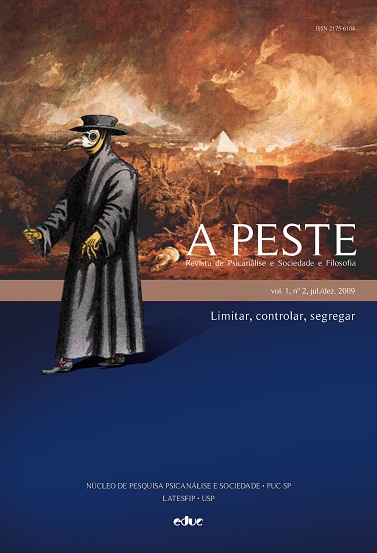O corpo e os discursos: dominação e segregação nos laços encarnados
DOI:
https://doi.org/10.5546/peste.v1i2.6278Resumo
Resumo: Este artigo sustenta-se na doutrina lacaniana dos quatro discursos para mostrar que o laço social entre os seres humanos é um “laço encarnado”, já que o corpo humano é também fato de discurso. Esse “laço encarnado”, entretanto, não se dá sem conflito, já que implica relações de poder que resultam em dominação e segregação. Mostrase a continuidade entre corpo e cosmos durante a Idade Média, época em que predominava o discurso do Mestre. Propõe-se que durante o Renascimento, na transição desse discurso para o Discurso Universitário, o corpo da mulher ofereceu resistência, o que se evidencia pelo sintoma social da fabricação de cadáveres nas fogueiras da inquisição. Mostra-se que, a partir do século XVII, com o imperativo da educação, o corpo da criança é que será o principal objeto do que Foucault nomeia “ortopedia discursiva”. Compreende-se que a partir da Revolução Industrial, com a aliança cada vez mais estreita entre a Ciência e o Capitalismo, e sobretudo após a Segunda Guerra, o corpo passou a ocupar um lugar central, confundindo-se com o indivíduo. Destaca-se o quanto o próprio corpo torna-se objeto de consumo, numa época em que, como sublinha Lacan, constatamos “a segregação trazida à ordem do dia por uma subversão sem precedentes” (LACAN, 1967/2003, p. 361). Palavras-chave: corpo; discursos; psicanálise; segregação. Abstract: This article is based on Lacan’s four discourses to show that the social bond between human beings is actually an “incarnate bond,” since the human body is also a fact of discourse. However, such “incarnate bond” is not without conflict inasmuch as it implies relationships of power resulting in domination and separation. The continuum between body and cosmos is shown in the Middle Ages, wherein the Discourse of the Master used to prevail. It is suggested that, during the Renaissance,while such discourse changed to the Discourse of the University, the body of the woman put up a fight, which is evidenced by the social symptom of strings of bodies burning at the stake of the Inquisition. It is shown that, as from the 17th Century, with education as an imperative, the body of the child would become the chief target of what Foucault named “discursive orthopedics.” It is understood that, starting with the Industrial Revolution, with an increasingly close-knit alliance between Science and Capitalism, and, most of all, after World War II, the body began playing a key role while entangling itself with the individual. The extent to which the body becomes an object of consumption at a time when, as Lacan underlines it, “separation [is] put on the agenda by an unprecedented subversion” is stressed. Keywords: body; discourses; psychoanalysis; separation.Métricas
Carregando Métricas ...
Downloads
Publicado
2011-07-18
Como Citar
Prates Pacheco, A. L. (2011). O corpo e os discursos: dominação e segregação nos laços encarnados. A PESTE: Revista De Psicanálise E Sociedade E Filosofia., 1(2). https://doi.org/10.5546/peste.v1i2.6278
Edição
Seção
Artigos

